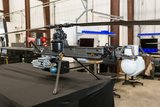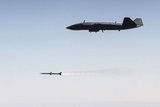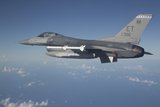General Atomics completes test of small UAS aerial recovery system
A towline being deployed from a GA-ASI MQ-20 Avenger UAS over Dugway Proving Ground, Utah. (Photo: General Atomics)
The towline for last month’s test was deployed from a General Atomics Aeronautical Systems (GA-ASI) MQ-20 Avenger UAS over Dugway Proving Ground, Utah.
The aerial recovery concept utilises a towline and smart end feature, which serves as a beacon and mechanical interface for aerial recovery.
The SUAS/ALE calculates its precise position relative to the smart end feature for navigation into towline intercept, followed by a manoeuvre to capture the end feature.
Related Articles
General Atomics achieves AI flight milestone with Avenger UAV
Once secure on the towline, the SUAS/ALE folds its wings and stops its engine to transition into a passively stable towed body. A podded hoist aboard the capital ship reels in the SUAS/ALE to a captive carriage state where the two platforms return to base together.
During this demonstration, a hoist from Breeze-Eastern equipped with GA-ASI’s smart end feature was integrated into Avenger’s payload bay. While in flight, the towline was deployed away from Avenger to the optimal distance for aerial recovery.
The smart end feature was able to wirelessly transmit its position back to Avenger, confirming its ability to transmit the data to a nearby SUAS/ALE for aerial recovery. The smart end feature’s deployed position correlated to GA-ASI’s multi-degree-of-freedom finite element catenary models, confirming its potential for SUAS/ALE aerial recovery.
Beyond just captive carry back to base, the SUAS/ALE can be refuelled, recharged, and/or rearmed and then redeployed. Redeployment can occur from the host aircraft, enabling SUAS/ALEs to conduct their own orbits from airborne launch and recovery positions.
Aerial redeployment allows UAS like GA-ASI’s Avenger or MQ-9A Reaper to serve as mobile command centers for a network of SUAS/ALEs in a persistent, expansive grid for surveillance, electronic attack, enemy air defence suppression, communication pathways, or joint all-domain mobile command and control for days or weeks at a time.
More from Air Warfare
-
![US approves potential $4.7 billion missile and air defence system sales to Denmark and Italy]()
US approves potential $4.7 billion missile and air defence system sales to Denmark and Italy
Italy could field the JASSM-ER for its combat aircraft including the F-35, while Denmark has been approved for AMRAAM and an Integrated Battle Command system procurement.
-
![Northrop Grumman to fly new Project Talon CCA by late 2026]()
Northrop Grumman to fly new Project Talon CCA by late 2026
The newly unveiled collaborative combat aircraft looks to strike a balance between capability and cost-effectiveness, according to the company.
-
![MBDA and Lockheed move closer to F-35A Meteor flight tests]()
MBDA and Lockheed move closer to F-35A Meteor flight tests
Following the completion of successful ground tests, one more exercise remains before flight testing can begin.





















